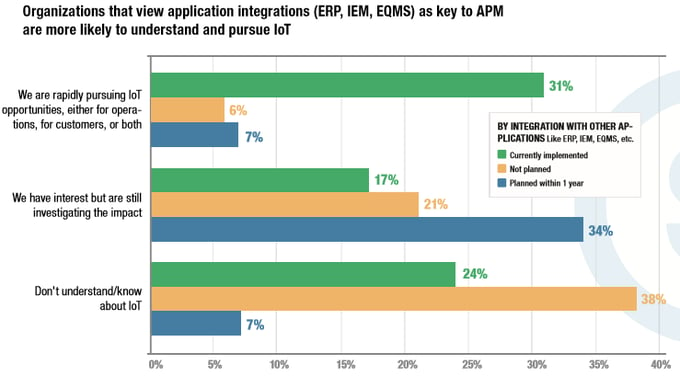When pursuing Digital Transformation efforts, it is important to understand the roadblocks one may face when moving forward. There is a direct correlation between education on new technologies such as Industrial Internet of Things (IIoT), an integral component of both Smart Connected Assets and Digital Transformation, and the ability to build a business case and therefore get the funding you require to execute on a project.
A common strategy we see across all industries is to start small, with pilot projects. This provides the opportunity to learn about the capabilities made available by technology providers and manufacturers, what works best for each case, and then to help build a future, larger business case. This typically provides the ammunition needed to address concerns of executive leadership and to get the buy-in required to fund more major projects.
What are the top roadblocks your company is facing in deploying IIoT technology?
The 5 Step journey to Digitally Transform with Smart Connected Assets
Smart Connected Assets is a vital component of your organization's Digital Transformation strategy, and to improved results, it requires a formalized approach. LNS has created a 5 step framework to support organizations as they venture down their path. Following this approach ensures you are taking into account the people, processes, and technology with your Digital Transformation initiatives. The most important thing to remember is that you are developing a solid foundation to build upon for years to come. To read more details behind the 5 step process, check out our eBook.
The Business Value of Smart Connected Assets
An earlier blog post discussed the value early adopters achieved through Smart Connected Assets. Most that use cases around Business Transformation have been in Asset Performance Management (APM). The data around these efforts is beginning to paint a picture of the potential with Smart Connected Assets.
Companies that do see value and are rapidly pursuing opportunities in Digital Transformation and Smart Connected Assets have integrated their APM solutions into other Operational Excellence pillars, like Enterprise Quality Management Systems (EQMS), Energy Management, and Enterprise Resource Planning (ERP). Therefore, the more mature companies are with best practices in people, processes, and technology; the more likely they will see direct benefits when investing in Smart Connected Assets.
Why? They have already taken the five-step journey and understand their Operational Architecture and its impact on Operational Excellence. This can be seen in the chart below, the companies that have taken an Operational Excellence approach to integrating the application that support it, are moving on to pursue the opportunities around IIoT.
 Recommendations & Actions
Recommendations & Actions
Although we are at the early stages of understanding the full business impact, early results point to competitive advantages in goods produced and new business models that will transform industries in the years to come. To move forward, here are some suggested actions to take with your Smart Connects Assets journey:
- Look to vendors that can deliver the needed capabilities of an IIoT Platform, Smart Connected Assets, Operations, or Enterprise: They should have an open view of technology platforms; proprietary capabilities do not belong and will be difficult to work with long-term.
- Vendor collaboration is critical for delivering on the vision of Smart Connects Assets and Operations: There will not be a one size fits all approach, so look to vendors with strong partnerships that can provide a broad reach across the platform.
- Do not forget people, processes, and the connection with operational performance benefits and ROI: As the information begins flowing, new ideas and resources will be required. Processes will change; getting ahead of this will extend competitive advantages and can be a value multiplier.
